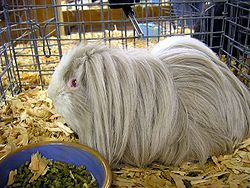Silkie Guinea Pig
Share

 The Silkie, called the “Sheltie” in England, was originally called the “Angora.” The Silkie is a rather new new breed and was only introduced in the 1970s. They were initially bred in the United Kingdom and are the offspring of a Peruvian and a “Self Black” guinea pig.
The Silkie, called the “Sheltie” in England, was originally called the “Angora.” The Silkie is a rather new new breed and was only introduced in the 1970s. They were initially bred in the United Kingdom and are the offspring of a Peruvian and a “Self Black” guinea pig.
The Silkie is a long-haired breed like the Peruvian Guinea Pig, but unlike the Peruvian, there is no long, frontal sweep or hair that covers the face. Instead, the hair sweeps back from the head forming a mane, and there is no part down the back.
When viewed from above, the Silkie appears to be tear-shaped, thanks to it’s wide body and smaller head, and the fur is soft, fine, and very shiny.
Most silkie owners consider their pets to be rather “shy” but very gentle and laid back. Use food to bribe them out of their cages and spend time teaching them to be more comfortable around humans. Since they require daily brushing, they are not recommended as pets for small children.
Silkie Satin
If you happen across a Silkie Satin, you should consider yourself lucky as they are quite rare. These guinea pigs have the same general appearance as the Silkie, but the coat has a glossy sheen, and feels like satin to the touch.
Grooming
Silkies tend to require a quite a lot of work due to their long, silky hair, which can easily become tangled and matted. You will need to brush them at least once a day (probably more often). Be sure to remove any tangles when you brush them out and be very gentle so they look forward to the event.
[bt_taglinebox style=”top” width=”500″ font_size=”12″ text_color=”#5b5b5b” title=”Guinea Pigs Like Routines” title_color=”#259b9a” align_center=”no” bgr_color=”#f6f6f6″]Once you get your pet into a schedule of being brushed, they’ll begin to look forward to the event.[/bt_taglinebox]Bathing is not recommended for most guinea pigs, but in the case of the Silkie, spot cleaning can be very helpful to keep their hair shiny. Use a clean, wet rag to gently wipe down their coat rather than give them a bath. You can do this every few weeks, but be sure you get them used to the technique at an early age or you’ll be causing them undue stress.
Colors
Silkies can be found in a wide variety of colors. Any color other than tan are acceptable for showing.
[bt_taglinebox style=”top” width=”500″ font_size=”12″ text_color=”#5b5b5b” title=”Roan Absynians” title_color=”#259b9a” align_center=”no” bgr_color=”#f6f6f6″]The color of Roan Abyssinian guinea pigs are due to a genetic deformation, and should never be bred with another roan. [/bt_taglinebox]Diet
Improper diet is the leading cause of illness in these pets. Be sure you’re feeding them a high-quality pellet food that is specifically designed for the breed, such as Oxbow Cavy Cuisine Adult Guinea Pig (Timothy Based), 10-Pound Bag. Commercial guinea pig pellets should make up the bulk of your pet’s diet as they are nutritionally complete, easily found at pet supply stores, and made from plants, seeds and veggies. Guinea pigs need to be fed twice a day, once in the morning and once in the evening.
Research the needs of your guinea pigs as they all require different things. Fresh fruit and raw vegetables should be offered to your guinea pig each day, as they make great chews and your guinea pig needs plenty of things to chew on as their teeth grow continually.
Guinea pigs need fresh hay available at all times. Timothy hay makes a good edible choice and can be found in the form of cubes or loose bags of hay.
Housing
Guinea pigs need at least eight square feet of floor space in their cages. They must have solid flooring as wire flooring can injure paws and break legs. Since guinea pigs are “prey” animals, they have two responses to a threat: Freeze in place or run away. This is why it’s very important that your guinea pig be able to move quickly without fear of being caught up on a wire. Your guinea pig will chew, so avoid cardboard boxes and be sure to inspect cage periodically.
Paper or pine bedding should be provided to allow your guinea pig plenty of comfortable nesting. Clean the cage at least once a week (twice a week is better) to remove any soiled bedding, food, or droppings. Each week, you’ll need to remove the old bedding, scrub the cage with warm water and rinsing thoroughly. This will help reduce odor and eliminate possible health problems.
[bt_taglinebox style=”top” width=”500″ font_size=”12″ text_color=”#5b5b5b” title=”Bedding” title_color=”#259b9a” align_center=”no” bgr_color=”#f6f6f6″]AVOID cedar shavings as they contain phenols which can be toxic to your guinea pig.[/bt_taglinebox]Training
While they are very personable animals, Silkies tend to be more shy than other breeds, so training can be rather challenging (but certainly not impossible!). Never leave them unattended outdoors without watching them like a hawk (or it’s likely a hawk will get them).
Despite being shy, they are very intelligent, so be sure you keep them mentally stimulated with plenty of toy, raw blocks of wood they can chew on, and offer plenty of ways they can get exercise. They are very sensitive to heat and cold, so be sure you keep them in an area that is away from windows and near a consistent form of heat or air-conditioning, without having it blowing on them.
[bt_youtube url=”https://www.youtube.com/watch?feature=player_embedded&v=HcpKO5KfU94″ width=”600″ height=”400″ responsive=”yes” autoplay=”no”][/bt_youtube]









